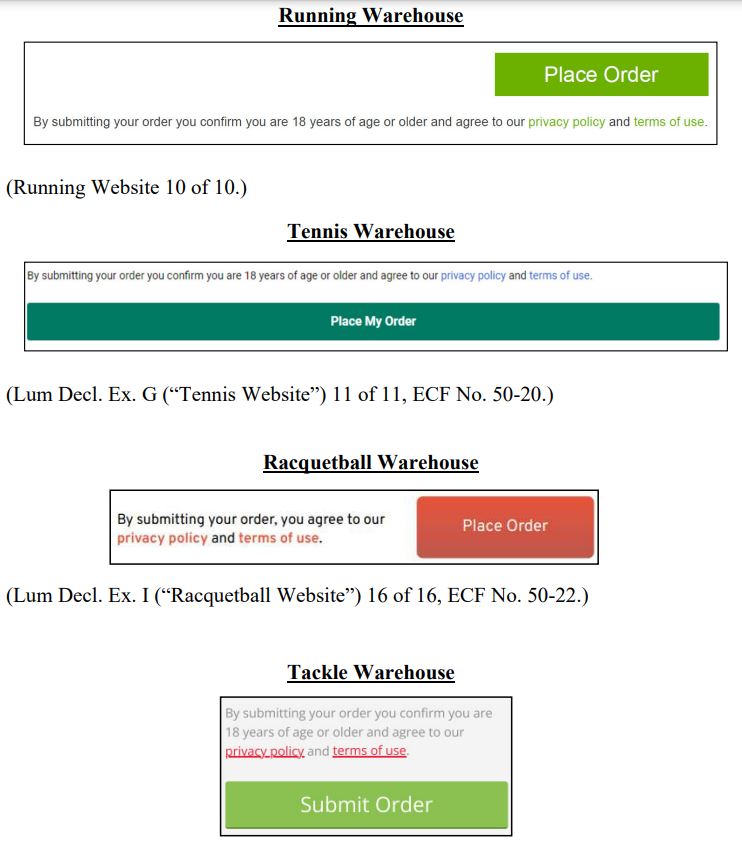Ninth Circuit Enforces a “Browsewrap” (That Was Actually a Clickthrough)–Patrick v. Running Warehouse
This is a data breach case. Several e-commerce sites were hit, first by hackers and then by plaintiffs’ lawyers. The sites invoked their TOSes to send the data breach cases to arbitration. The Ninth Circuit agrees.
The Ninth Circuit opinion doesn’t show the defendants’ screenshots, but the lower court opinion did:
As you can see, these are old-school clickthrough agreements. The screens all use an if-then statement predicated on a user’s click (by submitting your order, you agree to the TOS) and place the call-to-action near the “order” button, albeit in different places (above, below, to the side). Fifteen years ago, implementations like these were virtually always enforceable. Today, in the post-Nguyen world, sometimes courts accept nothing less than a two-click process (a “clickwrap”).
In an unfortunate move, the court calls these implementations “browsewraps.” They clearly are not. The Nguyen court defined browsewrap as “where the website’s terms and conditions of use were generally posted on the website via a hyperlink at the bottom of the screen.” This is clearly different. The call-to-action is more prominent and requires affirmative user action.
In the Berman case, the Ninth Circuit redefined browsewrap as “a website offers terms that are disclosed only through a hyperlink and the user supposedly manifests assent to those terms simply by continuing to use the website.” Even using the more expansive Berman redefinition, these screens are still not browsewraps. The if-then in these implementations isn’t the passive action of continuing to use the site, it’s the intentional and well-considered user action of ordering products.
Instead, these implementations are closest to a sign-in-wrap, another term that I wish would vanish from our parlance. A sign-in-wrap is a one-click formation process, like this is. However, the “sign-in” part of the “sign-in-wrap” phrasing refers to creating an account with login credentials, which this is not; this is ordering products without creating any account at all. I think the contradistinction to the sign-in-wrap paradigm pushed this panel towards the browsewrap classification, even though it didn’t fit either. This reinforces the continued problems with the “wrap” nomenclature, which doesn’t work and has never worked.
Instead of calling out that these implementations are neither browsewraps nor sign-in-wraps, this panel reaches the perilous conclusion that these “browsewraps” are enforceable:
Running Warehouse includes explicit notice on the final order review page, directly below key information such as the purchase total, and directly below the button Arcilla tapped to complete his purchase. The notice is on an uncluttered page and is not hidden or obscured. The notice is clear and legible, and the hyperlinked phrase “terms of use” is colored bright green—contrasted against the surrounding white background and adjacent black text. Moreover, the “terms of use” hyperlink is the same color as other clickable links on the page, suggesting clearly that it is a hyperlink.
[NOTE: The Meyer case enforced a TOS linked using a blue font that was underlined. Here, a green font without underlining still signals a legally significant hyperlink. The court says: “That the links are not blue, underlined, or capitalized does not undercut the district court’s conclusion that Running Warehouse provided Arcilla with ‘reasonably conspicuous notice’ of the Terms.”]
The court’s explanation of why the TOS should be enforced is sound (though it never expressly critiques the if-then part of the call-to-action); that’s why these types of implementations have been upheld for decades. So calling this an enforceable “browsewrap” was unnecessary and pernicious. Oy vey.
Upholding this implementation mends some of the problems created by the Berman case, where the call-to-action was too obscure for proper formation but sloppy language prompted lower courts to boost their formation expectations. Maybe this opinion will push lower courts back to their pre-Berman approach. Despite this ruling, I still plan to criticize anyone who says that browsewraps are enforceable. That includes the Ninth Circuit judges who perpetuated this semantic error. I have more to say about enforceable browsewraps in a forthcoming post. 😢
Case Citation: Patrick v. Running Warehouse, LLC, No. 22-56078 (9th Cir. Feb. 12, 2024)


Pingback: Another Court Finds an "Enforceable Browsewrap." MAKE IT STOP-Hawkins v. CMG - Technology & Marketing Law Blog()